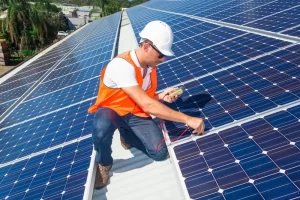The installation of solar panels in a studio demands careful consideration of the weight they impose on the roof. With individual panels averaging 40 to 50 pounds, the cumulative weight can considerably affect the structural integrity of the building. Evaluating the roof’s materials and design is essential to determine its suitability for supporting this load. Understanding how much roof weight can solar panels add is crucial to prevent costly issues, prompting a closer look at best practices for a secure installation.
Key Takeaways
- Solar panels weigh between 40 to 50 pounds each, impacting the overall weight on your studio’s roof.
- An average installation of 20 panels adds 800 to 1,000 pounds, necessitating a structural assessment.
- Evaluate your roof’s materials, age, and condition to ensure it can support the additional weight safely.
- Consider environmental factors, such as snow load and wind pressure, which can further stress your roof.
- Engage a qualified engineer to assess load capacity and utilize lightweight panels to minimize strain.
Understanding the Basics of Solar Panel Weight
Understanding the weight of solar panels is fundamental for any installation project, particularly for structures like studios where roof integrity is paramount. Solar panels typically weigh between 40 to 50 pounds per panel, depending on the model and materials used. This weight, while manageable for many structures, necessitates a thorough assessment of the supporting roof structure. It is important to take into account not only the weight of the panels themselves but also the additional weight from mounting hardware and potential snow accumulation. Accurate calculations and a detailed understanding of the roof’s load-bearing capacity are essential to guarantee safety and longevity. This knowledge fosters a sense of community among studio owners, as they collectively navigate the complexities of solar panel installation while prioritizing their shared investment in sustainability.
How Much Roof Weight Can Solar Panels Add?
When considering solar panel installation, it is essential to assess how much roof weight solar panels can add to a structure. Typically, solar panels weigh between 40 to 50 pounds each, and the total weight depends on the number of panels installed. For an average residential system of 20 panels, the additional weight can range from 800 to 1,000 pounds. This added weight must be factored into the overall structural integrity of the building. Additionally, the distribution of this weight across the roof’s surface is critical; improper installation may lead to localized stress points. Understanding how much roof weight solar panels can add is crucial for ensuring the safety and longevity of the structure, fostering a sense of security and confidence among homeowners.
Assessing Your Studio’s Roof Structure
A thorough evaluation of the studio’s roof structure is essential before installing solar panels. This assessment involves inspecting the materials, age, and overall condition of the roof, as these factors notably influence its ability to support additional weight. Roofs constructed with reinforced trusses or beams typically provide a more secure foundation for solar panel installation. Additionally, understanding the roof’s pitch and design is vital, as they affect both installation methods and the potential for water drainage. By conducting a detailed analysis, studio owners can guarantee that their roof can accommodate the additional weight from solar panels. This proactive approach not only enhances safety but also contributes to the longevity and effectiveness of the solar energy system.
Factors Influencing Roof Weight Capacity
Roof weight capacity is determined by several essential factors, each playing a notable role in the overall stability and durability of the structure. The material composition of the roof, such as wood, metal, or concrete, greatly affects its load-bearing capabilities. Additionally, the design and structural integrity, including truss configurations and support beams, are paramount in evaluating how much roof weight can solar panels add. Environmental factors, including snow load and wind pressure, must also be considered, as these can impose additional stresses on the roof. Finally, the age and condition of the roof are vital; older or compromised structures may not safely accommodate the added weight of solar panels, necessitating careful evaluation before installation.
Best Practices for Solar Panel Installation on Your Roof
Understanding the structural capacity of a roof is vital before proceeding with solar panel installation. Evaluating how much roof weight solar panels can add involves engaging a qualified engineer to assess the load-bearing capabilities of the existing structure. Proper installation begins with selecting lightweight panels, which can minimize additional stress. Utilizing a certified installer guarantees compliance with local codes and best practices, particularly regarding anchoring systems and spacing. Maintaining proper ventilation beneath panels is essential to prevent heat buildup and potential damage. Regular inspections post-installation can identify any structural concerns early on. By adhering to these best practices, studio owners can secure efficient energy production while safeguarding the integrity of their roofs.
Frequently Asked Questions
Can Solar Panel Installation Affect My Roof’s Warranty?
Installing solar panels can potentially affect a roof’s warranty if improper installation techniques or materials are used. It’s crucial to consult the warranty terms and engage certified professionals to guarantee compliance and protection against future issues.
How Do Solar Panels Perform in Extreme Weather Conditions?
Solar panels generally perform well in extreme weather conditions, with many designed to withstand high winds, hail, and heavy snow. Their durability guarantees reliable energy generation, contributing to long-term sustainability and efficiency for users.
Are There Specific Regulations for Solar Panel Installation in My Area?
Regulations for solar panel installation vary by locality, typically encompassing structural safety, zoning laws, and permitting processes. Homeowners should consult local authorities to guarantee compliance with all relevant codes and standards prior to installation.
What Is the Lifespan of Solar Panels?
The lifespan of solar panels typically ranges from 25 to 30 years. This longevity is influenced by factors such as manufacturing quality, installation practices, and environmental conditions, which collectively contribute to their overall performance and efficiency over time.
Can I Install Solar Panels on a Flat Roof?
Installing solar panels on a flat roof is feasible, provided structural integrity is assessed. Considerations include weight distribution, drainage, and local regulations, ensuring the roof can support the added load without compromising safety or functionality.
Conclusion
To summarize, comprehending the weight implications of solar panels is crucial for ensuring the structural integrity of a studio’s roof. With potential additional loads ranging from 800 to 1,000 pounds for a typical installation, thorough assessment of the roof’s materials and design is essential. Engaging a qualified engineer and considering lightweight panel options are best practices that not only safeguard the roof but also enhance the long-term viability and efficiency of solar energy utilization in residential settings.
You May Also Like To Read:


